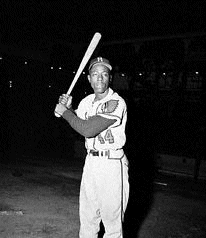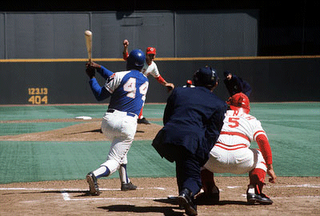715... and Counting
One more blurb before we move on to other topics (at least for about another 41 home runs, which should happen in about another 320-500 AB's). Barry just skipped by The Babe. Just to give equal time to contrary opinions:
Here are two pics of Hank Aaron, one from his rookie season. Notice the slender build, 24" waist, and narrow shoulders. On the right, is a photo of Hammerin' Hank hitting #714 in Riverfront stadium. Notice the much larger ass. Also, note the movement to switch to metric, in center field.


Here, see Barry from his rookie season on the left. Notice the the bling and the look of disdain on his face. On the right, you can see a fun photo showing Barry and Babe, side by side (though, this is a photo of younger Babe, not older, fatter, hot dog eating Babe). Notice Barry's broader shoulders and big ass, as well. Perhaps a commonality among guys that hit 714 or more home runs is the large ass. I think that I met some women at a bachelorette party last night that may have a shot at 714 home runs. Then again, I may be hitting a few home runs myself.
So what does all of this mean? Well, people get bigger as they get older. Some just get big and fat, like Babe or Boomer Wells. Others stay looking pretty good, like Hank or Barry. And like I've said before, why does no one ever talk about something as interesting as how Hank Aaron put up his best two seasons at ages 37 and 39? Looking a little more closely at it (http://www.baseball-reference.com/a/aaronha01.shtml), you also see that Hank also did it while putting up numbers that were well above his career rates (about 10 HR/AB in those two seasons, compared to a career 16.4). Could it be that it's possible to dial in as a power hitter, late in your career, despite being a much more all-around player earlier in your career? Everyone is talking about how unprecedented Barry's change is. I think that you only have to look at Barry's next hurdle.
I'm not saying that Hank was on anything. I'm just saying that maybe we're all blowing things out of proportion w/ Bonds. If anything, the things that we are looking at probably aren't the things that we should be looking at. You can look at general trends across time. But, for the most direct comparison, looking at stats that compare a player his peers makes the most sense (normalizing the environment as best as you can). Then you can take these normalized numbers and try to make better sense of them. Look here (http://www.baseball-reference.com/leaders/OPSplus_career.shtml) for a list of all-time OPS+ leaders (an average OPS = 100, and 150 means that you are 150% better than the league average). This is a relatively crude way of doing it, but it does show this comparison.
On the bright side, we probably won't have to hear about this for a little while, as Barry chases Hank.
-Chairman
I'm not saying that Hank was on anything. I'm just saying that maybe we're all blowing things out of proportion w/ Bonds. If anything, the things that we are looking at probably aren't the things that we should be looking at. You can look at general trends across time. But, for the most direct comparison, looking at stats that compare a player his peers makes the most sense (normalizing the environment as best as you can). Then you can take these normalized numbers and try to make better sense of them. Look here (http://www.baseball-reference.com/leaders/OPSplus_career.shtml) for a list of all-time OPS+ leaders (an average OPS = 100, and 150 means that you are 150% better than the league average). This is a relatively crude way of doing it, but it does show this comparison.
On the bright side, we probably won't have to hear about this for a little while, as Barry chases Hank.
-Chairman



No comments:
Post a Comment